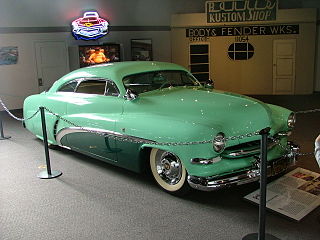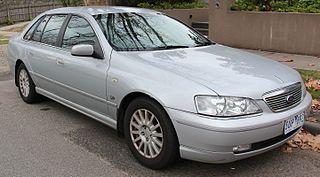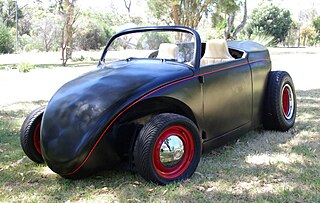Related Research Articles

Case modification, commonly referred to as case modding, is the modification of a computer case or a video game console chassis. Modifying a computer case in any non-standard way is considered a case mod. Modding is done, particularly by hardware enthusiasts, to show off a computer's apparent power by showing off the internal hardware, and also to make it look aesthetically pleasing to the owner.

The Studebaker Gran Turismo Hawk was a grand touring coupe sold by Studebaker motors between 1962 and 1964. The top of the Studebaker line, it was the final development of the Hawk series that began with the Golden Hawk in 1956.
The 1957 and 1958Packard lineup of automobiles were based on Studebaker models: restyled, rebadged, and given more luxurious interiors. After 1956 production, the Packard engine and transmission factory was leased to the Curtiss-Wright Corporation while the assembly plant on Detroit's East Grand Boulevard was sold, ending the line of Packard-built cars. However, Studebaker-Packard executives hoped to keep the Packard name alive until a fully restyled model could be funded, developed, and produced. These cars were built in hopes that enough would be sold to enable the company to design and build a completely new luxury Packard.

Pimp My Ride is an American television series produced by MTV and hosted by rapper Xzibit, which ran for six seasons on MTV from 2004 to 2007. In each episode, a car in poor condition is both restored and customized. The work on the show was done by West Coast Customs until season 5 and was done by Galpin Auto Sports thereafter.

The Pontiac Astre is a subcompact automobile that was marketed by Pontiac as a rebadged variant of the Chevrolet Vega. Initially marketed in Canada for model years 1973–1974, the Astre debuted in the U.S. for the 1975 model year, competing with other domestic and foreign subcompacts that included the Mercury Bobcat, Volkswagen Rabbit, and Toyota Corolla.

The Ambassador is an automobile manufactured and marketed by American Motors Corporation (AMC) from 1957 through 1974 over eight generations, available in two- and four-door sedan, two-door hardtop, four-door station wagon as well as two-door convertible body styles. It was classified as a full-size car from 1957 through 1961, mid-size from 1962 until 1966, and again full-size from 1967 through 1974 model years.

The Chevrolet Chevy II/Nova is a small automobile manufactured by Chevrolet, and produced in five generations for the 1962 through 1979, and 1985 through 1988 model years. Nova was the top model in the Chevy II lineup through 1968. The Chevy II nameplate was dropped after 1968, with Nova becoming the nameplate for all of the 1969 through 1979 models. Built on the X-body platform, the Nova was replaced by the 1980 Chevrolet Citation introduced in the spring of 1979. The Nova nameplate returned in 1985, produced through 1988 as a S-car based, NUMMI manufactured, subcompact based on the front wheel drive, Japan home-based Toyota Sprinter.

The Cadillac Calais is an automobile that was the entry-level Cadillac model that was sold from 1965 to 1976. Cadillac renamed its low-priced Series 62 in 1965 as the "Calais", after the French port city of Calais that overlooks the narrowest point in the English Channel. In Greek mythology, Calais was one of two winged sons of Boreas, god of the North Wind, and Oreithyea. With the exception of no convertible model, the Calais shared the same styling and mechanics as the better-equipped, more expensive Cadillac de Ville.

The Buick LeSabre is a full-size car made by the division Buick of General Motors from 1959 until 2005. Prior to 1959, this position had been retained by the full-size Buick Special model (1936–58). The "LeSabre", which is French for "the sabre", was Buick's mid-level full-size sedan above the Special but below the Electra during the 1960s then remained in its market position when the Electra was replaced with the Park Avenue. The LeSabre was available as a 2-door convertible, sedan or hardtop, a 4-door sedan or hardtop and station wagon throughout its production.

The Cadillac Series 70 is a full-size V8-powered series of cars that were produced by Cadillac from the 1930s to the 1980s. It replaced the 1935 355E as the company's mainstream car just as the much less expensive Series 60 was introduced. The Series 72 and 67 were similar to the Series 75 but the 72 and 67 were produced on a slightly shorter and longer wheelbase respectively. The Series 72 was only produced in 1940 and the Series 67 was only produced in 1941 and 1942. For much of the postwar era, it was the top-of-the-line Cadillac, and was Cadillac's factory-built limousine offering.

A custom car is a passenger vehicle that has been either substantially altered to improve its performance, often by altering or replacing the engine and transmission; made into a personal "styling" statement, using paintwork and aftermarket accessories to make the car look unlike any car as delivered from the factory; or some combination of both. A desire among some automotive enthusiasts in the United States is to push "styling and performance a step beyond the showroom floor - to truly craft an automobile of one's own." A custom car in British according to Collins English Dictionary is built to the buyer's own specifications.

The Ford Fairlane and LTD are full-sized luxury vehicles produced in a series of models by Ford Australia between 1959 and 2007.
The Willys Aero was a line of passenger cars manufactured first by Willys-Overland and later by Kaiser-Willys Corporation from 1952 through 1955 in the United States of America. It was also produced in Brazil from 1960 to 1971.
A pimpmobile is a large luxury vehicle, usually a 1960s, 1970s or 1980s-model Lincoln, Cadillac, Buick or Chrysler vehicle, that has been customized in a garish, extravagant and kitsch or campy style. The style is largely an American phenomenon.

Volksrods are modified Volkswagen beetles. They are used as an alternative to traditional Ford-based hot rods. Classic Ford Model Ts and Model As are becoming more scarce and more valuable than ever. VW Beetles are much more affordable, easier to find, and easier to find parts for. It is also a 1930s design, which is well-suited to hot-rodding's roots and tradition.

The Moskvitch-408 series is a small family car produced by the Soviet car manufacturer MZMA/AZLK between 1964 and 1975. The first prototype was made in 1960.

A lead sled is a standard production automobile with a body heavily modified in particular ways(see below); especially, though not exclusively, a 1949, 1950, or 1951 model year Ford 'Shoebox' or Mercury Eight car. In the name, "lead" refers to the use of lead as a bodyfiller in early days, and "sled" refers to the lowering of the vehicle, giving these vehicles the appearance that they were "slip sliding" down the highway.

Kustoms are modified cars from the 1930s to the early 1960s, done in the customizing styles of that time period. The usage of a "K" for "Kustom" rather than a "C", is believed to have originated with George Barris.

The Hirohata Merc is a 1950s lead sled custom car, often called "the most famous custom of the classic era". Setting a style and an attitude, it had a "momentous effect" on custom car builders, appeared in several magazines at the time and has reappeared numerous times since, earning an honorable mention on Rod & Custom's "Twenty Best of All Time" list in 1991. The impact may be measured by the fact that, after more than fifty years and numerous owners, it is still known as "the Hirohata Merc".

CadZZilla is a custom car built by Boyd Coddington.